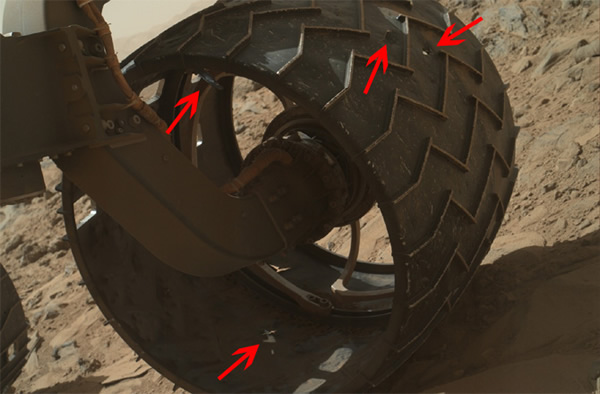Rough Roving: Curiosity's Wheel Damage 'Accelerated'
A photograph taken by Curiosity's robotic arm-mounted Mars Hand Lens Imager (MAHLI) on Dec. 20 (Sol 488) shows marked wear and tear on the rover's front left wheel. Punctures in the rover's thin aluminum are highlighted by the arrows.
In May, Discovery News reported the dramatic signs of wear and tear on Mars rover Curiosity’s wheels. The aircraft-grade aluminum material appeared scratched, dented, even punctured.
At the time, lead rover driver Matt Heverly said that the damage was to be expected. “The ‘skin’ of the wheel is only 0.75mm thick and we expect dents, dings, and even a few holes due to the wheels interacting with the rocks,” he said via email. Despite the assurances that the holes were just a part of Curiosity’s mission, there seems to be increasing concern for the wheels’ worsening condition after the one-ton robot rolled over some craggy terrain.
In an upcoming driving activity for Curiosity, rover drivers will command Curiosity to rove across a relatively smooth area of the Martian surface. Throughout the drive, Curiosity’s powerful MAHLI camera, which is mounted to the end of the rover’s robotic arm, will monitor the condition of the wheels.
“We want to take a full inventory of the condition of the wheels,” said Jim Erickson, project manager for the NASA Mars Science Laboratory at NASA’s Jet Propulsion Laboratory, Pasadena, Calif. “Dents and holes were anticipated, but the amount of wear appears to have accelerated in the past month or so. It appears to be correlated with driving over rougher terrain. The wheels can sustain significant damage without impairing the rover’s ability to drive. However, we would like to understand the impact that this terrain type has on the wheels, to help with planning future drives.”
Curiosity has recent endured some challenging terrain laced with sharp rocks protruding from the ground. These rocks have caused some perforations in the six wheels, sometimes peeling back flaps of cut aluminum.
Depending on the outcome of the upcoming monitoring session, mission managers may need to better factor in the roughness of terrain of Curiosity’s future drives, re-routing if necessary.
Since landing inside Gale Crater in August 2012, Curiosity has driven a little under three miles, so damage to the wheels was going to be inevitable. But the rover hasn’t even begun the tough drive up the slopes of Aeolis Mons (Mount Sharp), a 5.5 kilometer-high mountain in the center of the crater — the ultimate goal of the mission to piece together the habitability puzzle of the red planet. There will undoubtedly be some tense times ahead for the rover team, especially if the rough terrain continues to chew up the six aluminum wheels.(Dec 20, 2013 05:36 PM ET // by Ian O'Neill)












